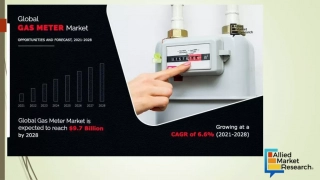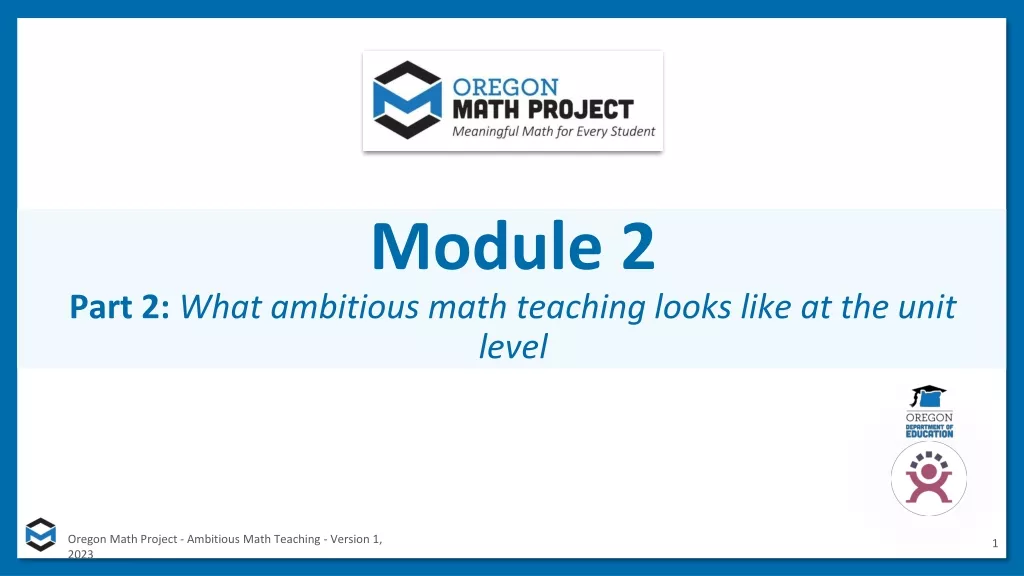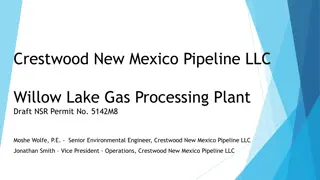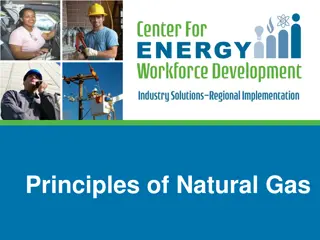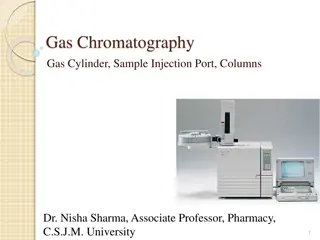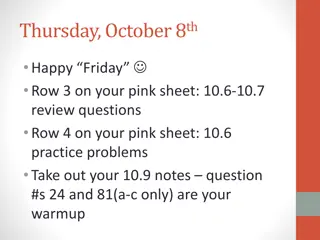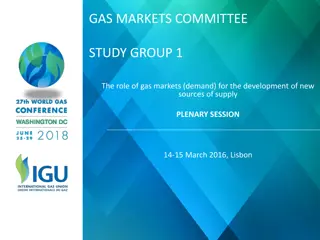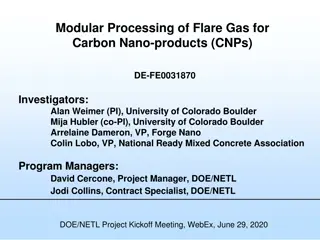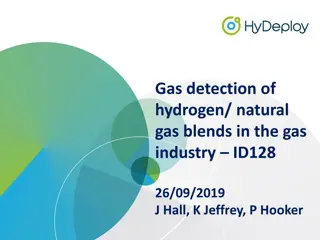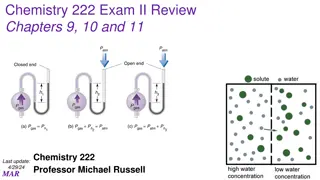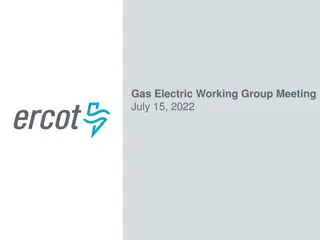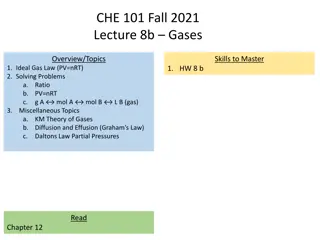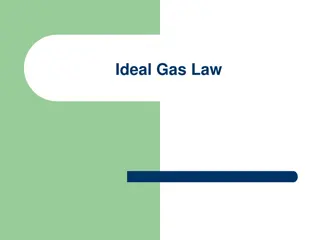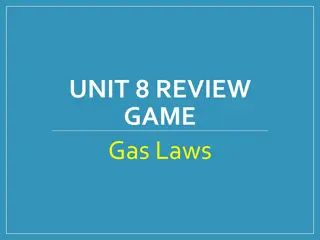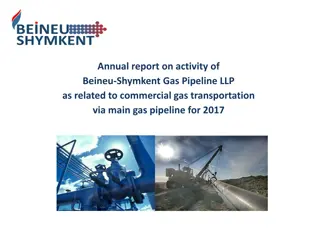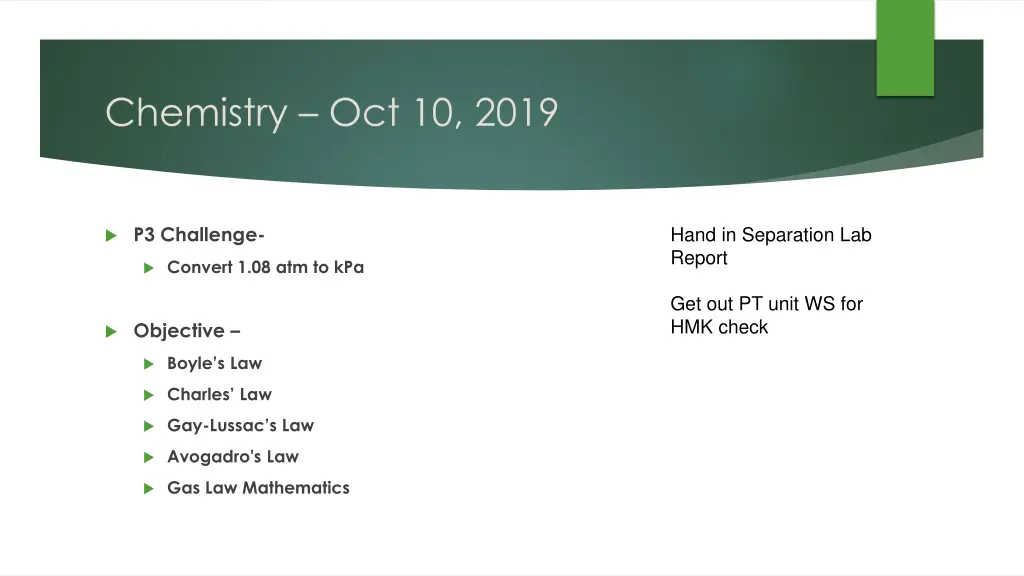
Gas Laws Fundamentals and Applications
Explore the fundamental gas laws including Boyle's Law, Charles's Law, Gay-Lussac's Law, and Avogadro's Law, and learn how to solve gas problems by understanding the relationships between pressure, volume, temperature, and moles of gas. Discover the inverse and direct proportional relationships and how to apply them in gas calculations.
Download Presentation

Please find below an Image/Link to download the presentation.
The content on the website is provided AS IS for your information and personal use only. It may not be sold, licensed, or shared on other websites without obtaining consent from the author. If you encounter any issues during the download, it is possible that the publisher has removed the file from their server.
You are allowed to download the files provided on this website for personal or commercial use, subject to the condition that they are used lawfully. All files are the property of their respective owners.
The content on the website is provided AS IS for your information and personal use only. It may not be sold, licensed, or shared on other websites without obtaining consent from the author.
E N D
Presentation Transcript
Chemistry Oct 10, 2019 P3 Challenge- Hand in Separation Lab Report Convert 1.08 atm to kPa Get out PT unit WS for HMK check Objective Boyle s Law Charles Law Gay-Lussac s Law Avogadro's Law Gas Law Mathematics
Variables for gases There are four variables that can be measured and describe a gas: Pressure, P Volume, V Temperature, T Moles of gas, n If you know the measurements for all four of these variables you have a complete description of a sample of gas. We will look at how these variables are related to one another.
Boyles Law Consider any given sample of gas in a compressible container. As you compress the gas, what happens to the pressure of the gas? Consider a cylinder with a piston attached As mass increases, height decreases As pressure increases, volume decreases
Boyles Law You will find that pressure and volume are inversely proportional Graph P vs V is a curve. From KMT, Pressure is due to collisions of gas particles with the walls of the container. If the container is flexible, as you compress a gas (V ), more particles will hit the walls (P ). As you expand a gas (V )., fewer particles will hit the walls (P ).
How to solve gas problems Identify given information using units as your guide. Summarize in a table. Determine what information is constant and mark with C for initial final and effect. If both initial and final values are known, indicate the effect with an up or down arrow. Determine the effect for the other variable and predict whether the missing information will be higher or lower than the given information. P T V Initial Final Effect
Sample Problem Ex: A cylinder with a moveable piston has an applied pressure of 4.0 atm and a volume of 6.0 L. Will the volume of the cylinder be greater or less than 6.0 L if the applied pressure is decreased to 1.0 atm? P T V Initial 4.0 atm 6.0 L C Final 1.0 atm C Effect C
Charless Law Generally, if temperature increases, then volume increases. Specifically you will find they are directly proportional. Graph is a straight line through the origin. Note: Pressure is held constant and T is in Kelvin. From KMT: higher Temp collisions Larger volume faster particles more
Gay-Lussacs Law Generally, if temperature increases, then pressure increases as we saw in the lab last time. (Note the similarity to Charles Law.) Specifically you will find they are directly proportional. Graph is a straight line through the origin. Note: Volume is held constant and T is in Kelvin. From KMT: higher Temp forceful collisions faster particles Higher pressure more
Avogadros Law The amount /number of gas particles present in a sample is measured in terms of moles, n When temperature and pressure are held constant, if the amount of gas is increased, the volume of the sample increases. (e.g. balloon) Experiments show that this is a direct proportionality. Graph is a straight line through the origin. From KMT: If there are more particles added, the only way to have the same pressure at the same temperature is to increase the size of the vessel
Simple Gas laws Summary Boyle s Law P V Pressure increases, Volume decreases. Vice versa. T constant. (n constant) Charles Law T V Temperature increases, Volume increases. Vice versa. P constant. (n constant) Guy-Lussac s Law T P Temperature increases, Pressure increases, Vice versa. V constant. (n constant) Avogadro s Law - n V Number of moles of gas increases, Volume increases. Vice versa. P and T constant.
Two possible options Variables may be directly or indirectly related. For direct variation, as one goes up, the other goes up. And if one goes down, the other goes down. X Y and X Y They are in sync. For indirect variation, as one goes up, the other goes down. X Y and X Y For direct variation, the graph of X vs Y is a line: For indirect variation, the graph is a curve: Y Direct: Y X = = Y kX k X Indirect: 1 X 1 X = = Y Y k XY k
Mathematics of Gas Laws = 1 1 PV PV For Boyles Law, P and V are inversely related so the equation can be used to solve. 2 2 For Charles Law, Gay-Lussac Law, and Avogadro s Law are directly related so the equations you can use all take the same form: 1 1 PV T PV V T V T P T P T V n V n = = = = 2 T 2 1 2 1 2 1 2 1 2 1 2 1 2 1 2 Or Charles Law and Gay-Lussac can be combined to become a combined Law Solve by cross multiplying.
Exit Slip and Assignment State Boyle s Law. What s Due? (Pending assignments to complete.) Qualitative Gas Laws Worksheet + Quantitative Bonus What s Next? (How to prepare for the next day) Energy, p38-45

